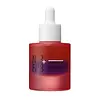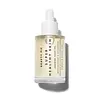What's inside
What's inside
 Key Ingredients
Key Ingredients

 Benefits
Benefits

 Concerns
Concerns

 Ingredients Side-by-side
Ingredients Side-by-side

Water
Skin ConditioningOrbignya Oleifera Seed Oil
EmollientPrunus Amygdalus Dulcis Oil
Skin ConditioningVitis Vinifera Seed Oil
EmollientAdansonia Digitata Seed Oil
EmollientPassiflora Edulis Seed Oil
EmollientGlycerin
HumectantCucurbita Pepo Seed Oil
EmollientHelianthus Annuus Seed Oil
EmollientPrunus Armeniaca Kernel Oil
MaskingPrunus Persica Kernel Oil
EmollientBakuchiol
AntimicrobialPalmitoyl Tripeptide-1
Skin ConditioningAcetyl Hexapeptide-8
HumectantCopper Tripeptide-1
Skin ConditioningSodium Hydroxide
BufferingCaprylic/Capric Triglyceride
MaskingCetyl Ethylhexanoate
EmollientGluconolactone
Skin ConditioningLimonene
PerfumingBrassica Campestris Seed Oil
Skin ConditioningSodium Benzoate
MaskingPolyglyceryl-3 Laurate
EmulsifyingGlycyrrhiza Glabra Root Extract
BleachingPolyglyceryl-3 Diisostearate
EmulsifyingCrithmum Maritimum Extract
Skin ConditioningTocopherol
AntioxidantAlthaea Officinalis Root Extract
Skin ConditioningOryza Sativa Bran Extract
Skin ConditioningMethyl Glucose Sesquistearate
EmollientCitrus Nobilis Peel Oil Expressed
PerfumingCalcium Gluconate
HumectantEthylhexyl Palmitate
EmollientLinalool
PerfumingTribehenin
EmollientSorbitan Isostearate
EmulsifyingWater, Orbignya Oleifera Seed Oil, Prunus Amygdalus Dulcis Oil, Vitis Vinifera Seed Oil, Adansonia Digitata Seed Oil, Passiflora Edulis Seed Oil, Glycerin, Cucurbita Pepo Seed Oil, Helianthus Annuus Seed Oil, Prunus Armeniaca Kernel Oil, Prunus Persica Kernel Oil, Bakuchiol, Palmitoyl Tripeptide-1, Acetyl Hexapeptide-8, Copper Tripeptide-1, Sodium Hydroxide, Caprylic/Capric Triglyceride, Cetyl Ethylhexanoate, Gluconolactone, Limonene, Brassica Campestris Seed Oil, Sodium Benzoate, Polyglyceryl-3 Laurate, Glycyrrhiza Glabra Root Extract, Polyglyceryl-3 Diisostearate, Crithmum Maritimum Extract, Tocopherol, Althaea Officinalis Root Extract, Oryza Sativa Bran Extract, Methyl Glucose Sesquistearate, Citrus Nobilis Peel Oil Expressed, Calcium Gluconate, Ethylhexyl Palmitate, Linalool, Tribehenin, Sorbitan Isostearate
Squalane
EmollientIsopropyl Palmitate
EmollientMacadamia Ternifolia Seed Oil
EmollientSesamum Indicum Seed Oil
EmollientSimmondsia Chinensis Seed Oil
EmollientLimnanthes Alba Seed Oil
Skin ConditioningPrunus Armeniaca Kernel Oil
MaskingBorago Officinalis Seed Oil
EmollientOenothera Biennis Oil
EmollientCaprylic/Capric Triglyceride
MaskingParfum
MaskingTocopherol
AntioxidantHelianthus Annuus Seed Oil
EmollientAlgae Extract
EmollientPadina Pavonica Thallus Extract
Skin ConditioningBrassica Campestris Seed Oil
Skin ConditioningDaucus Carota Sativa Root Extract
Skin ConditioningRosmarinus Officinalis Extract
AntimicrobialLimonene
PerfumingLinalool
PerfumingCoumarin
PerfumingSqualane, Isopropyl Palmitate, Macadamia Ternifolia Seed Oil, Sesamum Indicum Seed Oil, Simmondsia Chinensis Seed Oil, Limnanthes Alba Seed Oil, Prunus Armeniaca Kernel Oil, Borago Officinalis Seed Oil, Oenothera Biennis Oil, Caprylic/Capric Triglyceride, Parfum, Tocopherol, Helianthus Annuus Seed Oil, Algae Extract, Padina Pavonica Thallus Extract, Brassica Campestris Seed Oil, Daucus Carota Sativa Root Extract, Rosmarinus Officinalis Extract, Limonene, Linalool, Coumarin
Alternatives
Ingredients Explained
These ingredients are found in both products.
Ingredients higher up in an ingredient list are typically present in a larger amount.
Brassica Campestris Seed Oil is from the field mustard plant. This plant is classified as a cabbage.
Like other vegetable oils, this ingredient is an emollient. It helps sooth and soften the skin by trapping moisture in.
Brassica Campestris Seed Oil also contains antioxidants. Antioxidants help fight free-radical molecules. These unstable molecules may damage your skin cells. By helping to stabilize them, antioxidants may help with anti-aging.
Learn more about Brassica Campestris Seed OilThis ingredient is an emollient, solvent, and texture enhancer. It is considered a skin-softener by helping the skin prevent moisture loss.
It helps thicken a product's formula and makes it easier to spread by dissolving clumping compounds.
Caprylic Triglyceride is made by combining glycerin with coconut oil, forming a clear liquid.
While there is an assumption Caprylic Triglyceride can clog pores due to it being derived from coconut oil, there is no research supporting this.
Learn more about Caprylic/Capric TriglycerideHelianthus Annuus Seed Oil is the oil derived from the seeds of a Sunflower. Sunflower seed oil is non-fragrant. It is an emollient, meaning it helps to soften the skin.
Sunflower seed oil contains many fatty acids. The fatty acids found in sunflower seeds include (from highest amount to least): linoleic acid, myristic acid, palmitic acid, stearic acid, arachidic acid, oleic acid, and linolenic acid.
These fatty acids help the skin create ceramides. Ceramides play a role in repairing the skin barrier.
Helianthus Annuus Seed Oil helps moisturize the skin. This in turn helps the skin look more rejuvenated and smoother.
Sunflowers are rich in vitamin E.
Historians believe Indigenous cultures of North America domesticated sunflowers before corn. Thus they relied on sunflower oil for a variety of uses. One such use is moisturizing skin and hair.
Sunflower seed oil may not be fungal acne safe. We recommend speaking with a professional if you have any concerns.
Learn more about Helianthus Annuus Seed OilLimonene is a fragrance that adds scent and taste to a formulation.
It's found in the peel oil of citrus fruits and other plants such as lavender and eucalyptus. The scent of limonene is generally described as "sweet citrus".
Limonene acts as an antioxidant, meaning it helps neutralize free radicals.
When exposed to air, oxidized limonene may sensitize the skin. Because of this, limonene is often avoided by people with sensitive skin.
The term 'fragrance' is not regulated in many countries. In many cases, it is up to the brand to define this term. For instance, many brands choose to label themselves as "fragrance-free" because they are not using synthetic fragrances. However, their products may still contain ingredients such as essential oils that are considered a fragrance.
Learn more about LimoneneLinalool is a fragrance and helps add scent to products. It's derived from common plants such as cinnamon, mint, citrus, and lavender.
Like Limonene, this ingredient oxidizes when exposed to air. Oxidized linalool can cause allergies and skin sensitivity.
This ingredient has a scent that is floral, spicy tropical, and citrus-like.
Learn more about LinaloolThis ingredient is the oil from the apricot.
Apricot Kernel Oil is an emollient and helps soften skin. This is due to its fatty acid components. Some of these fatty acids include linoleic and oleic acid.
This ingredient also has antioxidant properties from Vitamins A, C, and E. Antioxidants help fight free-radicals. Free-radicals are molecules that may damage your skin cells. Besides being antioxidants, these vitamins provide plenty of skin benefits as well.
Learn more about Prunus Armeniaca Kernel OilTocopherol (also known as Vitamin E) is a common antioxidant used to help protect the skin from free-radicals and strengthen the skin barrier. It's also fat soluble - this means our skin is great at absorbing it.
Vitamin E also helps keep your natural skin lipids healthy. Your lipid skin barrier naturally consists of lipids, ceramides, and fatty acids. Vitamin E offers extra protection for your skin’s lipid barrier, keeping your skin healthy and nourished.
Another benefit is a bit of UV protection. Vitamin E helps reduce the damage caused by UVB rays. (It should not replace your sunscreen). Combining it with Vitamin C can decrease sunburned cells and hyperpigmentation after UV exposure.
You might have noticed Vitamin E + C often paired together. This is because it is great at stabilizing Vitamin C. Using the two together helps increase the effectiveness of both ingredients.
There are often claims that Vitamin E can reduce/prevent scarring, but these claims haven't been confirmed by scientific research.
Learn more about Tocopherol